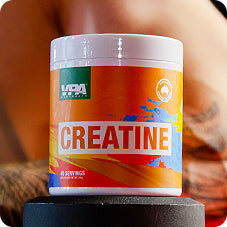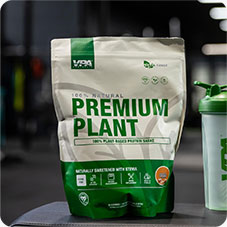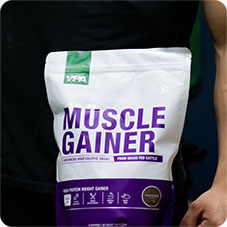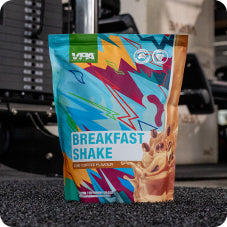Your Cart is Empty
How large should a calorie surplus be for muscle gain?
January 14, 2021 6 min read

One of the biggest questions in the fitness space is how to gain muscle as quickly and efficiently as possible. And while a calorie surplus is not always necessary for gaining muscle, no matter how you look at it, a calorie surplus is going to be a necessary step for doing it in the most efficient way possible.
If the goal were just to gain muscle as quickly as possible, it would make sense to utilise a large calorie surplus. But this is where efficiency comes in.
A large calorie surplus is likely going to lead to a lot more fat gain and an unfavourable ratio of fat to muscle gain. This then either leads to more time having to be spent dropping body fat down the line, or just decreases how long you can be in a calorie surplus for before having to drop back to maintenance calories. Therefore, too large of a calorie surplus is typically inefficient since it slows down the process of getting to your ideal physique.
The more pressing question is how large a calorie surplus should be to optimise muscle gain while keeping fat gain down at an acceptable level.
Variables Involved
The first thing I want to point out is that there is not going to be a stock standard answer. I am going to assume that everybody reading this article is doing some form of resistance training. If the goal is muscle gain, then that is obviously going to be important.
If you enter a calorie surplus without any training stimulus, you will likely still gain some muscle, but the ratio of fat to muscle is going to be terrible.
Outside of that, it is important to think about your potential for muscle gain. The calorie surplus is going to determine how much weight you gain, whereas the other variables are going to influence the ratio of muscle to fat.
Looking it from that perspective it is important to consider:
- How long you have been training
- How old you are
- Your gender
- How optimally your training is set up
- The overall quality of your diet, particularly ensuring you are consuming sufficient protein
- Genetics
- Whether you are natural or enhanced (PED usage)
- Sleep quality/quantity
- Stress levels
If you are a young male with minimal life stress who is new to training, on a good training program with a good diet, with good genetics for gaining muscle and also getting great sleep, then you probably should have a slightly larger calorie surplus. The further away you get from that description, the smaller the surplus should be.
In particular, the closer you get to your potential best physique, the less potential for muscle gain you have left. If you were trying to push hard into a surplus at that stage, it would be ill-advised.
Textbook Recommendations and the Issue With Them
Personally, my first proper introduction into concepts related calories and macros came from spending time on the bodybuilding.com forums. On that forum, people would talk about how a 500 calorie surplus would result in roughly a 1/2kg per week weight gain. And a 1000kcal per day surplus would be double that at almost 1kg per week.
This is backed up by similar recommendations in nutrition textbooks that that base it on the composition of muscle mass and how much energy is required to create that muscle mass.
Muscle is roughly 75% water, 20% protein and 5% fat, glycogen and other minerals and metabolites. So these calculations are often based off a combination of the calories required to build that amount of muscle, using the amount of calories required for the protein, fat and glycogen.
I like the simplicity of this idea, but unfortunately, it is more complex than this.
Reasons why it can be almost impossible to come up with a clean number include:
- As calorie intake increases, the number of calories burned through the thermic effect of food increases. The thermic effect of food is typically 8-15% of total daily energy expenditure.
- As calorie intake increase, calories burned through non-exercise activity thermogenesis typically increases. And this impact varies drastically different in different individuals
- As calorie intake increases and energy availability improves, the basal metabolic rate might adjust slightly. This impact is more pronounced if coming from a low energy availability state where the body had to down-regulate some processes that burn calories.
- When you are on restricted calories, the body can become slightly more “efficient” during exercise and burn slightly fewer calories. Obviously, in a surplus, energy expenditure can change related to that.
There are a whole bunch more factors. But this dramatically increases complexity. For example, if you give somebody a 500kcal surplus, is it ACTUALLY a 500kcal surplus if their energy expenditure increases by 250kcal due to having more calories coming in? One person’s expenditure might increase by a small amount, while another person’s might increase by a larger amount.
The way I look at it, although we have heaps of ways we can theoretically think about this, all that we really care about is what happens in practice. We only really care about what ratio is muscle vs fat at different calorie surplus sizes.
So What Is The Ideal Size?
Even though this is an area that a lot of people are curious about there is a surprisingly small amount of research on the topic.
- For people who are new to training and have everything in their favour, 1-2kg per month is probably going to be ideal.
- For females I would likely go at the more conservative end of that spectrum.
- As people progress, I would look at slowing it down towards that <0.5kg per month mark at the other end of the extreme, for somebody really close to their potential.
Going higher than these rates is okay if you are willing to embrace some more fat gain. From an anecdotal perspective, it is interesting to note that from I can tell, a large percentage of people who have done a major transformation with their physique over the years have done something called a “dreamer bulk” at some stage early in their training career.
A dreamer bulk is where you spend an extended period of time in a larger than ideal calorie surplus, under the impression that a lot of what you are gaining is muscle, and then end up disappointed that a large percentage was fat. Often for males this will be a 15-20kg total gain in bodyweight over this timeframe as well.
So it’s interesting to note that a lot of people with great physiques have made this mistake and most of them regret it and now recommend smaller calorie surpluses, but it is something that a lot of them have in common.
How to get started
The first step is going to be aiming to figure out your maintenance calories. To do this, you could use an online calorie calculator which will give you a PREDICTION for the amount of calories required to maintain your weight.
Following this, if you want to be precise, you will need to eat roughly that amount of calories for a few weeks to see what happens.
If your weight increases, it was a surplus, if it decreases, it was a deficit. If it is steady, then it was maintenance calories. Then you will need to adjust as necessary.
From there, you should add the required number of calories for your goals e.g. adding 250-500kcal if everything is in your favour.
But beyond just the number of calories, my preference is to aim for a change in weight based on a certain timeframe. This accounts for the changes in energy expenditure related to increased calories.
So, if your goal is to gain 1kg per month, and you are gaining 0.5kg per month, it would make sense to increase calories. If you were gaining at 2-3kg per month, it would make sense to reduce calories.
Summary
At the end of the day, it really depends on your situation and your goals. If you really care about staying lean while building muscle, it makes sense to go on the lower end of the spectrum. If you do not care about fat gain, it makes sense to go on the higher end of the spectrum.
From my perspective, if your goal is to completely transform your physique, it makes sense to aim for that sweet spot in the middle where you are consistently gaining size, without gaining more fat than necessary.
What We Recommend
Also in Featured

Creatine Capsules vs Powder — Which Is Better for Strength and Performance?
November 06, 2025 6 min read
Read More
Running Gels Explained — What They Are, How They Work, and When to Use Them
November 06, 2025 10 min read
Read More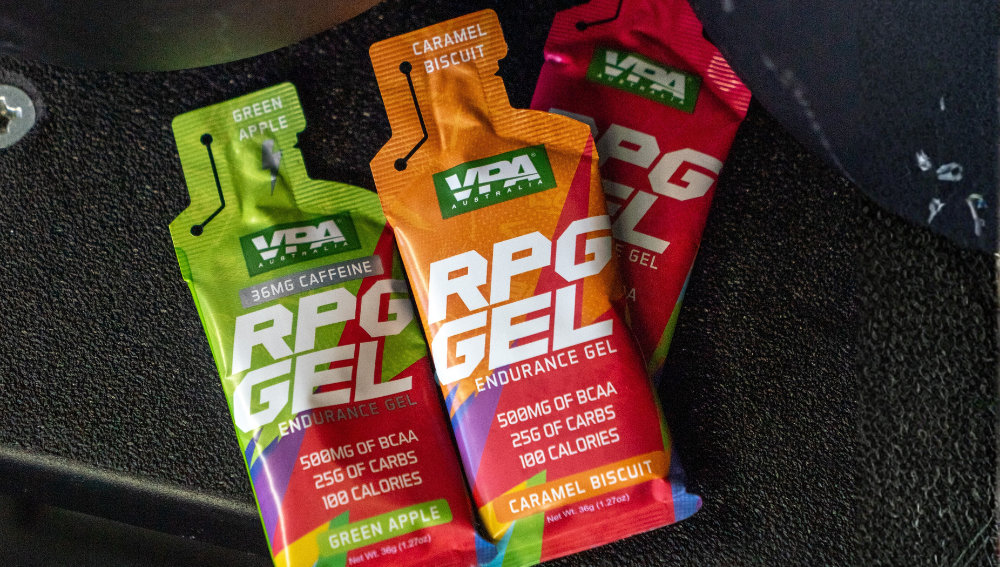
Why Energy Gels Are a Game-Changer for HYROX Athletes and Functional Fitness Training
October 15, 2025 6 min read
Read More Recent Articles
- Creatine Capsules vs Powder — Which Is Better for Strength and Performance?
- Running Gels Explained — What They Are, How They Work, and When to Use Them
- Why Energy Gels Are a Game-Changer for HYROX Athletes and Functional Fitness Training
- Body Type Diet: How to Eat for Your Ectomorph, Mesomorph or Endomorph Build
- The Best Way to Take Creatine for Maximum Results (2025 Guide)
- Creatine Gummies Scam? What You Need to Know vs Powder
- 10 Proven Whey Protein Benefits (and Why WPI Might Be the Best Option)
- Third-Party Tested Supplements in Australia: Why It Matters More Than Ever
- 7 Best Protein Powders for Weight Loss in Australia (Updated 2025)
- Prebiotic Collagen Protein for Gut Health and Weight Loss: What You Should Know
${{amount}}




